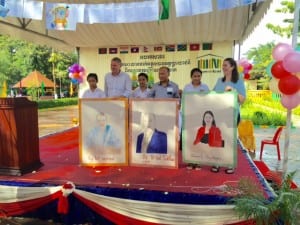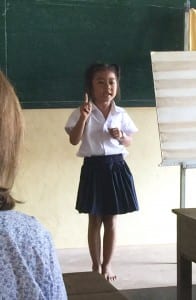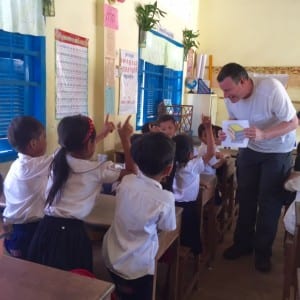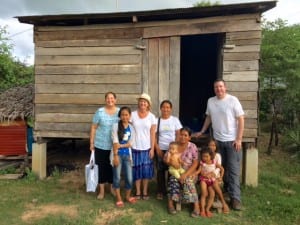Room to Read set a bold goal fifteen years ago, at its inception, to reach 10 million children with its literacy and girls’ education programs by 2020. Ketchum CEO, Rob Flaherty and his wife Tammy joined the Room to Read founders and several donors at a ceremony outside Siem Reap, Cambodia to celebrate this major milestone, achieved well ahead of schedule. The visit included two days of visits to several schools and libraries established by Room to Read. Rob also provided communications training to the Room to Read board on how to best communicate their new five-year strategic plan. Below are Rob’s impressions of his time in Cambodia in support of Room to Read…

Portraits drawn by students were presented to Room to Read founders (from left): John Wood, Dinesh Shrestha and Erin Ganju.
Cambodia, one of 10 countries served by Room to Read, was a perfect location and context for this ceremony. Despite one of the lowest per capita incomes in the world, we found the Cambodian people to be proud and gracious.
Their economic conditions have been created by decades of political upheaval and wars. As one of our guides told us, “Cambodia doesn’t have earthquakes, volcanoes, typhoons or hurricanes. Only human disasters.” A long procession of the country’s leaders maintained rule by suppressing education.

A future prime minister of Cambodia? A first grader leads one of the classes that Rob and Tammy visited.
Within this context you quickly realize that Room to Read in Cambodia isn’t just a team of do-gooders with books; they are a persistent, stubborn team of freedom fighters, bringing independence and economic mobility through education.
At a stirring, emotional ceremony at the Kna Primary School 20 minutes outside of Siem Reap, co-founder John Wood proclaimed, “We did it!” Serenaded by the school band, John described how Room to Read‘s “caravan of literacy” was succeeding because of its partnership with school leaders, parents, local government leaders and donors, including Ketchum. He framed it well with the saying, “If you want to travel fast, travel alone. If you want to travel far, travel together.”
With a look to the future and the journey ahead, Room to Read co-founder and CEO Erin Ganju said, “What we have learned along the way makes the difference: we know what works. If we continue to apply what we learn and continue to improve, we can eradicate literacy in our lifetime.”

Rob teaches English to first grade students in Siem Reap, Cambodia.
For a closer look at the ceremony and 10 key learnings Room to Read has gained about education, please click here.
After the ceremony we had the opportunity to observe a classroom in the school of nearly 900 students. I attended a class in the first grade and the teacher asked me to teach the students some words in English.
Six of us also visited the home of a 14-year-old girl currently receiving support through the Girls’ Education Program. Wow! The young Ni-Nigh (my spelling) was poised, mature beyond her age and deeply appreciative of the opportunity Room to Read was providing. She is completely committed to being the first member of her family to graduate from high school.

With the help of Room to Read, 14-year-old Ni-Nigh (second from left) plans to be the first in her family to complete high school.
I knew that there are nearly 30,000 girls currently in the program and that Room to Read has established 17,500 libraries and built 2,000 schools. But meeting Ni-Nigh made a real impression. Ironically I realized that the only way I could fully appreciate the scale and global impact of Room to Read was to see and feel it at the individual level.




